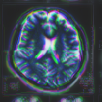Sector for Neuropsychiatric Disease Research
Sector overview
Modern psychiatry faces multiple fundamental challenges, including difficulties in diagnosis, confusion in disease classification systems, difficulties in individualizing treatment and the absence of newly developed drugs for psychiatric diseases. The main reason for these challenges is that the pathophysiology of psychiatric disorders is largely unexplored. Factors contributing to the lack of understanding of the pathophysiology of psychiatric disorders include the heterogeneity of the pathophysiology of psychiatric disorders and the absence of specific biomarkers for various pathomechanisms. To overcome these challenges, the Sector for Neuropsychiatric Disease Research is developing innovative PET tracers for a wide variety of neuropsychiatric disorders. Another important mission of our sector is to promote clinical research using these innovative PET tracers and to elucidate the diverse pathophysiology of psychiatric disorders.
The Sector for Neuropsychiatric Disease Research conducts the following research.
Development of high-contrast imaging biomarker for Chronic Traumatic Encephalopathy (CTE)
We are conducting a longitudinal cohort study on chronic traumatic encephalopathy (CTE). We reported depositions following various types of traumatic brain injury can be successfully visualized by tau PET for the first time (Takahata et al.,Brain 2019). Currently, we are collaborating with Boston University to develop a high-contrast PET tracer for chronic traumatic encephalopathy.
Research to elucidate the pathogenesis of secondary tauopathy following various CNS diseases
Recently, cyroEM studies have revealed that tau aggregates identical to CTE tau fold accumulate in the brain in subacute sclerosing panencephalitis (SSPE) and Kii ALS/PDC. In this study, tau PET imaging will be performed in patients with SSPE, Kii ALS/PDC, epilepsy, sequelae of organophosphate poisoning, and autoimmune encephalitis to clarify the pathogenetic mechanism of secondary tauopathy.
Development of novel PET tracers for neuropsychiatric disorders
We are promoting the development of novel imaging biomarkers for various pathomechanisms of neuropsychiatric disorders. In particular, we are focusing on the visualization of proteinopathy (tau, TDP-43 etc) neuroinflammation, and neurotransmitter dysfunction in neuropsychiatric disorders.
Tau PET imaging cohort of late-life psychiatric disorders
In 2020, we reported that part of late-life depression is tauopathy for the first time (Moriguchi et al., 2020). Currently, we are conducting a large scale clinical study using longitudinal tau PET assessments using 18F-florzolotau and neuropathological evaluation of postmortem brain samples of late-life psychiatric disorders.
Neuroinflammation PET study of Long COVID
In collaboration with Keio University School of Medicine, we are conducting neuroinflammatory PET imaging research on the pathophysiology of Long COVID. The goal of this study is to develop translatable imaging biomarkers for the pathophysiology of long COVID.
Longitudinal PET studies to elucidate the synaptic pathology of Alzheimer’s disease
We are collaborating with Yokohama City University School of Medicine to visualize the dysregulation of AMPA receptors in Alzheimer’s disease and other neurodegenerative diseases.
PET imaging studies for various neuropsychiatric disorders
We are conducting clinical research using various novel PET tracers for psychiatric disorders such as depression and schizophrenia. We have previously reported abnormalities of the norepinephrine transporter in depression (Moriguchi et al., American Journal of Psychiatry 2017), abnormalities of the dopamine second messenger system in schizophrenia (Kubota et al. Schizophrenia Bulletin 2023), abnormalities of the dopamine second messenger system in bipolar disorder (Yamamoto et al., under review), comprehensive imaging of dopamine neurotransmission mechanisms (Yamamoto et al., EJNMMI 2023 ), and abnormal serotonin neurotransmission in depression (Kitamura et al., International Journal of Neuropsychopharmacology 2023).
Research on image-pathologcical correlation analysis using postmortem brain samples
Validation using human postmortem brains is a critical step in the development of imaging biomarkers. We are collaborating with National Center of Neurology and Psychiatry, Niigata University Brain Research Institute, Shimofusa Psychiatric Center, Boston University, Mayo Clinic, and others.
Sector Leader
Keisuke Takahata, M.D., Ph.D.
https://www.researchgate.net/profile/Keisuke-Takahata-2https://scholar.google.co.jp/citations?user=flAaZdgAAAAJ&hl=ja

Selected publications
- Takahata, K. et al. PET-detectable tau pathology correlates with long-term neuropsychiatric outcomes in patients with traumatic brain injury. Brain 142, 3265–3279 (2019).
- Takahata, K. et al. First-in-human in vivo imaging and quantification of monoacylglycerol lipase in the brain: a PET study with 18F-T-401. Eur. J. Nucl. Med. Mol. Imaging 49, 3150–3161 (2022).
- Miyata, M. et al. Association between mammillary body atrophy and memory impairment in retired athletes with a history of repetitive mild traumatic brain injury. Sci. Rep. 14, 7129 (2024).
- Yamamoto, Y. et al. Association of protein distribution and gene expression revealed by positron emission tomography and postmortem gene expression in the dopaminergic system of the human brain. Eur. J. Nucl. Med. Mol. Imaging 50, 3928–3936 (2023).
- Tagai, K. et al. High-Contrast In Vivo Imaging of Tau Pathologies in Alzheimer’s and Non-Alzheimer’s Disease Tauopathies. Neuron 109, 42-58.e8 (2021).
- Moriguchi, S. et al. Excess tau PET ligand retention in elderly patients with major depressive disorder. Mol. Psychiatry 26, 5856–5863 (2021).
- Yamamoto, Y. et al. Differential associations of dopamine synthesis capacity with the dopamine transporter and D2 receptor availability as assessed by PET in the living human brain. Neuroimage 117543 (2020).
- Takahata, K. et al. A human PET study of [11C]HMS011, a potential radioligand for AMPA receptors. EJNMMI Res. 7, 63 (2017).
- Takahata, K. et al. Emergence of realism: Enhanced visual artistry and high accuracy of visual numerosity representation after left prefrontal damage. Neuropsychologia 57, 38–49 (2014).
- Takahata, K. et al. It’s not my fault: postdictive modulation of intentional binding by monetary gains and losses. PLoS One 7, e53421 (2012).
- Takahata, K. et al. Striatal and extrastriatal dopamine D₂ receptor occupancy by the partial agonist antipsychotic drug aripiprazole in the human brain: a positron emission tomography study with [11C]raclopride and [11C]FLB457. Psychopharmacology 222, 165–172 (2012).




